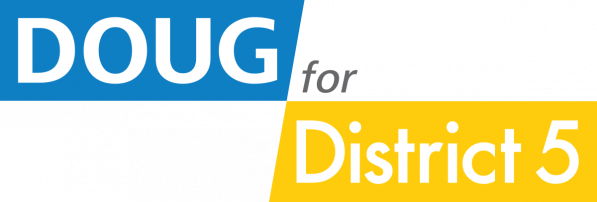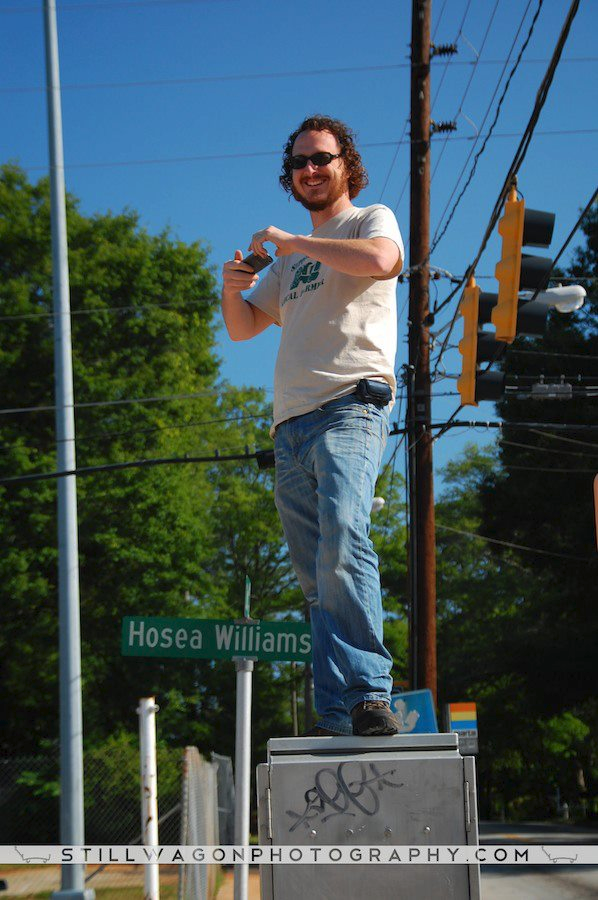How This Started
In 2002 Amy and I bought our first home in Atlanta in the East Lake neighborhood. It was a cute little 1947 cottage with hardwood floors and fireplace, across the street from a park. I spent two years working on my wife’s honey-do list as I made her gardening dreams come to life. (The workers at Home Depot suggested a direct deposit plan to cut out the middleman of the bank getting my paycheck.)
I didn’t really explore the surrounding community at first, but I went to a few neighborhood meetings and found that the park was a big concern. (I’ll never forget my first meeting, where ELNCA President Miles Bondurant presented Major Carlos Banda from Zone 6 with a gallon freezer bag full of crack bags that had been pulled from the park.) I was recruited to the East Lake Neighbors Community Association board and took on parks and beautification in January of 2005.
From what I am told, up to then, the ELNCA was a somewhat apolitical organization that viewed working with politicians as a chore. My view was that the city controls the police, parks, roads, water, and trash, and if we want those things to get better we need to develop that relationship. The city tended to ignore East Lake as it is on the extended east end of the city and had already gone from the highest crime rate in the state to one of the lower crime areas in the city, mostly limited to property crime.
Parks especially interested me because they are literally our common ground. East Lake had no downtown or business district where people could gather. 4th, cottage grove, and Memorial were mostly Auto shops and vacant buildings. 2nd & Hosea was four rundown corners. Our park was a source of community concern and frustration, representative of poor service and neglect from the city. More than one person told me “don’t be disappointed if it doesn’t work, the city has been ignoring things here for over 30 years.” That made it my mission. Building a better park created an opportunity for building a better community as we could engage our neighbors in setting goals, hold the city government accountable, and realize our common vision together.
I started working with our city councilperson Natalyn Archibong, and a group called Park Pride, which helps Atlanta communities adopt their parks. Things got fun real quick. Park pride was starting a partnership with the Home Depot and an organization called Kaboom to work with communities to build new playgrounds. This worked out great because my honey-do list had now expanded to East Lake Park.
One of the first things we did was a community survey to ask neighbors and park users to evaluate and rate the park, its equipment needs, and condition. Amy is a pediatric physical therapist. She is one of my personal heroes. We looked at the limited equipment there and realized it was dangerous and inaccessible to many. So park pride and playground equipment became my focus.
Meanwhile, the then neighborhood president had started a really cool concept called Neighbor in Need, which is focused on keeping seniors in their homes by taking care of major home repairs. An opportunity came up that Spring to help with the playground build at Toomer elementary with the Atlanta Falcons and Home Depot as sponsors, so I volunteered to help my neighbors and learn the process of building a playground. I also had a secondary motive, to try and get Home Depot to give Neighbor in Need a discount.
When I went to work at the playground build, one of the people from Home Depot said that the request I was making needed to be made with this fellow named Kevin, so I went and chatted up Kevin. I gave him the hard sell on Neighbor In Need and how it was such an incredible resource for seniors in our community. He in turn had a lot of questions about East Lake. At this point, everybody knew the East Lake story, how the community was transformed by replacing rundown public housing with mixed-income housing and reinvestments in a neighborhood elementary school. I tried to steer Kevin back to Neighbor In Need and he, in turn, had more questions about East Lake.
The conversation continued this way until he asked about our parks, at which point I got frustrated and said “Look I appreciate your interest in our community, and especially in our parks because I lead that effort, but honestly it’s just a means to an end.” Kevin said, “what do you mean”. I said “look I’m a young white guy moving into a majority black neighborhood and when I go to my neighborhood meetings I don’t see a lot of the older residents showing up, so the viewpoints are all those of the new people. I don’t think that’s beneficial to building our community. We don’t have a town square to bring people together, and many of my neighbors don’t see that they have much in common with each other. The one common thing we all have is the park. It’s the one thing everybody cares about, so that’s our common ground. That’s where I’m looking to try and build community, that’s where I’m engaging my neighbors and trying to get them involved so they see our neighborhood as a shared responsibility. If I can get them to help and participate in the process of building something better, it’s a means to the end of trying to build community, but PLEASE listen to me when I tell you that we really need to help our seniors in the community. Kevin thanked me and said he would give strong consideration to everything I had said.
The next day I got a call from Park Pride. They said “congratulations you have a new corporate sponsor! This is not going to be the way we planned it, we’re not going to be dealing with 100 volunteers and a $30,000 budget.” I said, “that’s fine if I can even just get 20 volunteers and a $10,000 budget I know we can make improvements and show our neighbors that we can make positive change by working together”. They said “No that’s not your problem. The Kevin you spoke to at the playground build yesterday, is the head of the Home Depot Foundation. He said you got really frustrated with him while reading him his mission statement. They want to make your park project the centerpiece of their month of service, they want it to be the Keystone project for the nation. You have a $100,000 budget and 1000 volunteers coming your way. The problem is we don’t make playgrounds that big.”
This changed everything. I felt like we had just been shot out of a slingshot. We put our park plans into fast forward, holding weekly meetings with what would end up being hundreds of residents participating and sharing their vision for the park. It was the perfect opportunity to engage our community. We had the capacity to affect immediate positive change from within. While most of the money would come from Home Depot, the design plans and goals would be community-driven, and my neighbors could take an active role in creating the community they wanted to live in.
We went to Little League parents and the local schools and had neighborhood children participate in the playground design. We went to the seniors’ group, “The Easy Goers” who met at the Community Center and asked them for their thoughts and concerns. We put out park surveys in the newsletter and email listserv and asked our neighbors to help set our goals and plans for improvement. The list of which was substantial, much of it beyond the scope of what we could do with volunteers. Our neighbors wanted a new playground for sure, but also wanted an area where people can sit while their children were playing, and possibly a track around it so parents could do laps. We came up with a grove of Crepe Myrtles that could grow out and provide shade for the area, plus expansion of the tree canopy and more planting beds. People wanted to see a lot of improvement to physical infrastructure, more benches, a shade pavilion, information boards, and especially the new planting beds throughout the park. Improvements to the baseball field, tennis courts, and basketball courts were a given, but so was reducing drug activity and drinking alcohol in the park as well as abuse by people from outside the community who treated the park as something they could trash while leaving their mess for our neighbors. Because of the immediate need to meet a fall deadline, we ended up being the first community to complete a park vision plan with Park Pride.
We came up with a lot but still needed more projects, as many of our goals were beyond what we could do with volunteers in an afternoon. We expanded to add improvements to our local elementary schools, painting mural panels at East Lake Elementary to block the view of the cemetery from the playground and built benches for Drew Elementary. In all, we came up with 36 separate work projects on 3 different work sites.
I wasn’t sure if we were going to be able to get enough volunteers from within the community and wanted to use the build day as a way of engaging our community neighbors, so I reached out to Saint Phillip’s AME Church and the Atlanta Masjid Al Islam, two big religious congregations in our community, to ask their leaders for help. I also had in mind that these two groups probably did not work together, and this was a great bridge-building opportunity in our community. (This was a little more important at the time for the mosque because we were just a few years removed from 9/11 and anti-Muslim tensions were still pretty high.) In the end, we had more than we needed and were told to cut off our volunteers at 150, but our volunteer organizer swore that she could have delivered another 100 if she had been allowed.
In a little over 6 hours, our neighbors accomplished transformative change in our community, not by writing a check or having a patron do things for us, but by working together and using our hands to build community together. We started to shift from a community that had things done for them, to a community that started to do things for itself, and that began a fantastic journey of building better together.


Doug, you are quite a leader! I’m amazed at the project “Park” and how you not only received funds, but arranged cooperation between groups that might not have worked together in the first place. Way to go! God bless! Keep up the great work.
I’m also quite impressed with the senior project of getting help for those who need repairs on their home, but can either not afford them, or cannot do them because of physical limitations. I’m going to present this idea to a Habitat for Humanities group in my Iowa area. In one of my travels to Minnesota, one H for H group did offer help to their local senior community at reduced rates. Do you have H for H in Atlanta? Just an idea for you. . . Anyhow, congratulations on your forward-thinking “Connections for all ages!” Your great aunt by marriage, Donna.